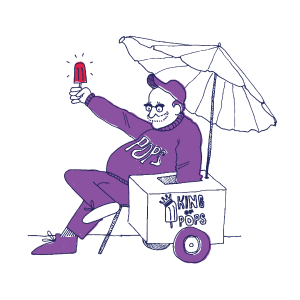The process of forecasting is tedious, time consuming, and can feel like a complete waste of time.
If you own a small business and haven't created a forecast yet, 😱 don't waste any more time. Starting a forecast should be a top priority. Chances are it is more important than anything else you are doing today or this week.
What seems like a straight forward process always leads to an "ah-ha" moment once your estimated revenues and expenses are plotted for the year. (for a real treat expand your forecasting process to five years to see how things might end up)
We assume that our brains on their own are capable of managing all of this data, so many of us avoid the process altogether. When we are consciously thinking about it, it seems obvious, but as soon as we get back to work on growing the business we quickly lose sight of the details.
A forecast couldn't be more simple. You only need to know two things.
- How much revenue do you think you’ll bring in each month?
- How much cash do you think you’ll spend each month?
The process of forecasting can be as simple as writing those thoughts down to come back to when major opportunities or unexpected expenses arise.
King of Pops is a seasonal business. Unless there is a pandemic, we make money for eight months and lose money for four months. That is a great start, but how much we make during the eight months and how much we lose in the four months is where things get interesting, and ultimately what decides if we'll survive or not.
When my brother Nick and I were the only employees managing our businesses’ seasonality was pretty straight forward. Our first employees were paid $1000 a week and we were up front that their seasonal job would end in late October. We had a shared kitchen that we paid for by the hour, and sold out of push carts that did not pay rent.
During the slow months we’d stop working and take long (unpaid) vacation, usually to a different continent. For four months revenue and expenses were very close to zero.
Then in Spring we’d get back to it and sprint as fast as we could to earn as much as we could.
We never said it out loud, but we were taking a very cautious path to growing our business. We weren’t taking on outside capital, we paid off our credit cards every month, and we only bought things knew we could afford.
I would have internally rolled my eyes at someone suggesting that I needed to create a forecast for such a straight forward business.
However, I think we would have been well served if we would have started a forecasting process back then. I think we would have grown smarter and spent more strategically.
Those guesses, the ones that feel like throwing jello against the wall, have more insight than you might appreciate. And if you can find someone to talk to you about why you made that guess you’ll see it isn’t so much of a guess after all.
Right now we are in the final stages of forecasting for our family of businesses (called Rainbow Umbrella). We produce, distribute, and sell our products. We sell to stores, out of carts carts, in bars and through franchisees. There are people with extensive knowledge of each piece of our business, and they are responsible for forecasting the numbers they are most close to.
Not only does this make our forecast more accurate, it makes it a living tool that motivates the person who made the forecast to make it so.
I am surprised by the number of entrepreneurs who have not yet embraced the practice of forecasting. I encourage you to begin by creating a copy of this Google Sheet and making an effort to complete it to the best of your ability. Don't overthink it, simply take that first step towards forecasting.
You’ll thank me later.
Tags:
Financials
November 28, 2023 at 6:49 PM


